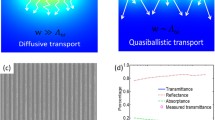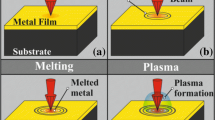Abstract
Heat transfer processes, induced by ultrashort laser pulses in thin gold films, were studied with a time resolution of 50 fs. It is demonstrated that in thin gold films heat is transmitted by means of electron–phonon and phonon–phonon interactions, and dissipated on nanoscale within 800 fs. Measurements show that the electron–phonon relaxation time varies versus the probe wavelength from 1.6 to 0.8 ps for λ=560–630 nm. The applied mathematical model is a result of transforming the two-temperature model to the hyperbolic heat equation, based on assumptions that the electron gas is heated up instantaneously and applying Cattaneo’s law to the phonon subsystem, agrees well with the experimental results. This model allows us to define time of electron–phonon scattering as the ratio of the heat penetration depth to the speed of sound in the bulk material that, in turn, provides an explanation of experimental results that show the dependence of the electron–phonon relaxation time on the wavelength.




Similar content being viewed by others
References
D. Cahill, W. Ford, K. Goodson, G. Mahan, A. Majumdar, H. Maris, R. Merlin, S. Phillpot, J. Appl. Phys. 93, 793 (2003)
A. Dietzel, R. Berger, P. Mächtle, M. Despont, W. Häberle, R. Stutz, G. Binnig, P. Vettiger, Sens. Actuators A, Phys. 100, 123 (2002)
Y. Sun, D. Fangb, M. Sakaa, A.K. Soh, Int. J. Solids Struct. 45, 1993 (2008)
S. Anisimov, B. Kapeliovich, T. Perel’man, Sov. Phys. JETP 39, 375 (1974)
N. Singh, Int. J. Mod. Phys. B 24, 1141 (2010)
D.Y. Tzou, Macro to Microscale Heat Transfer: The Lagging Behavior (Taylor & Francis, New York, 1997)
G. Eesley, Phys. Rev. B 33, 2144 (1986)
W. Fann, R. Storz, H. Tom, J. Bokor, Phys. Rev. B 46, 13592 (1992)
W. Fann, R. Storz, H. Tom, J. Bokor, Phys. Rev. Lett. 68, 2834 (1992)
C. Sun, F. Vallee, L. Acioli, E. Ippen, J. Fujimoto, Phys. Rev. B 48, 12365 (1993)
T.Q. Qiu, T. Juhasz, C. Suarez, W.E. Bron, C.L. Tien, Int. J. Heat Mass Transf. 37, 2799 (1994)
R. Groeneveld, R. Sprik, A. Lagendijk, Phys. Rev. B 51, 11433 (1995)
Z. Lin, L. Zhigilei, V. Celli, Phys. Rev. B 77, 75133 (2008)
H. Sim, S. Park, T. Kim, Y. Choi, J. Lee, S. Lee, Mater. Trans. 51, 1156 (2010)
T.Q. Qiu, C.L. Tien, Int. J. Heat Mass Transf. 37, 2789 (1994)
J.J. Klossika, U. Gratzke, M. Vicanek, G. Simon, Phys. Rev. B 54, 10277 (1996)
J. Chen, J. Beraun, Numer. Heat Transf., Part A, Appl. 40, 1 (2001)
H. Inouye, K. Tanaka, I. Tanahashi, K. Hirao, Phys. Rev. B 57, 11334 (1998)
H. Hirori, T. Tachizaki, O. Matsuda, O. Wright, Phys. Rev. B 68, 113102 (2003)
D.W. Tang, N. Araki, J. Phys. D, Appl. Phys. 29, 2527 (1996)
S. Link, C. Burda, M. Mohamed, B. Nikoobakht, M. El-Sayed, Phys. Rev. B 61, 6086 (2000)
J. Shang, Z. Luo, C. Cong, J. Lin, T. Yu, G. Gurzadyan, Appl. Phys. Lett. 97, 163103 (2010)
R. Rosei, D. Lynch, Phys. Rev. B 5, 3883 (1972)
V.V. Kulish, L.J. Lage, J. Heat Transf. 122, 372 (2000)
J.I. Frankel, J. Thermophys. Heat Transf. 20, 945 (2006)
V.V. Kulish, L.J. Lage, L.P. Komarov, P.E. Raad, J. Heat Transf. 123, 1133 (2001)
D. Joseph, L. Preziosi, Rev. Mod. Phys. 61, 41 (1989)
M. Abramowitz, I. Stegun, Handbook of Mathematical Functions with Formulas, Graphs, and Mathematical Tables (US Government Printing Office, Washington, 2010)
V.V. Kulish, B.V. Novozhilov, Math. Probl. Eng. 4, 173 (2003)
J. Hohlfeld, D. Grosenick, U. Conrad, E. Matthias, Appl. Phys. A Mater. 60, 137 (1995). 129th WE-Heraeus-Seminar on Surface Studies by Nonlinear Laser Spectroscopies, Kassel, Germany, 30 May–1 June, 1994
J. Hohlfeld, J. Muller, S. Wellershoff, E. Matthias, Appl. Phys. B, Lasers Opt. 64, 387 (1997)
W. Rohsenow, J. Hartnett, E. Ganic, Handbook of Heat Transfer Fundamentals (McGraw-Hill, New York, 1985)
G. Kaye, T. Laby, Tables of Physical and Chemical Constants and Some Mathematical Functions (Harlow, Longman, 1995)
Acknowledgements
The authors are thankful to Prof. M.E. Michel-Beyerle for continuous support. This work is supported by the Singapore Agency for Science, Technology and Research (A*STAR), under research grant SERC GRANT No. 092 156 0123.
Author information
Authors and Affiliations
Corresponding authors
Appendix
Appendix
Following the solution procedure from [26], let us take the Laplace transform of (9). Taking into account that, initially, the system described by (9) is at thermal equilibrium and so \(\frac{\partial\theta}{\partial \xi}|_{\xi=0}=0\) and θ| ξ=0=0, we have
where Θ(η;s) and \(\tilde{Q}(\eta;s)\) are the Laplace transforms of θ(η,ξ) and \(\tilde{q}(\eta,\xi)\), respectively. The general solution of the nonhomogeneous equation (19) is
where \(\lambda(s)=\sqrt{2s+s^{2}}\). The two first terms on the right side of (20) are the general solution of the associated homogeneous equation with \(\tilde{Q}(\eta;s)=0\), and P(η;s) is a particular solution of (19).
For the problem in question and taking into account the fact that the surface heat flux is induced by the electron gas after absorbing the laser energy, the boundary conditions become
where \(\tilde{q}''=\frac{1}{\xi_{p}}\exp{(-a[\frac{\xi-\xi_{b}}{\xi_{p}}]^{2})}\) is the dimensionless form of the surface heat flux. Hence, the parameter C 1(s) must be zero, and (20) is simplified into
To eliminate C(s) from (22), the derivative of Θ(η;s) with respect to η is used:
Then, combining (22) and (23), and taking into account the relationship between the temperature gradient and the surface heat flux (21), the general solution of (20) can be written as
where \(\tilde{Q}''(s)\) is the Laplace transform of \(\tilde{q}''(s)\). The right part of (24) consists of the sum of two terms which are responsible for the temperature responses due to the surface heat flux and volumetric heating, respectively. Taking into account that the function \(\tilde{Q}(\eta;s)\) can be represented as a product of two functions, one of which depends on the complex variable s only, and the other is exp(−η/Δη), the particular solution of (20) can be written as follows:
Rights and permissions
About this article
Cite this article
Poletkin, K.V., Gurzadyan, G.G., Shang, J. et al. Ultrafast heat transfer on nanoscale in thin gold films. Appl. Phys. B 107, 137–143 (2012). https://doi.org/10.1007/s00340-011-4862-z
Received:
Revised:
Published:
Issue Date:
DOI: https://doi.org/10.1007/s00340-011-4862-z




